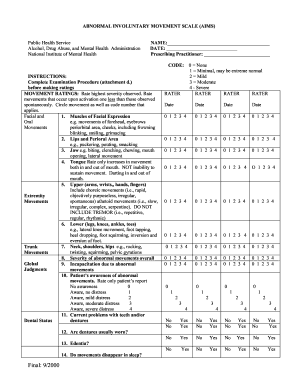Loading

Get Abnormal Involuntary Movement Scale (aims) 2000-2025
How it works
-
Open form follow the instructions
-
Easily sign the form with your finger
-
Send filled & signed form or save
How to fill out the Abnormal Involuntary Movement Scale (AIMS) online
The Abnormal Involuntary Movement Scale (AIMS) is a crucial tool for assessing involuntary movements in individuals. This guide provides clear, step-by-step instructions on how to fill out the AIMS form online, ensuring a comprehensive evaluation of abnormal movements.
Follow the steps to successfully complete the AIMS online.
- Press the ‘Get Form’ button to access the AIMS form and open it in the editor.
- Begin by entering the individual's name in the designated field.
- Fill in the date of the evaluation in the appropriate section.
- Provide the name of the prescribing practitioner in the specified field.
- Refer to the Examination Procedure document before making your ratings, as specified in the instructions.
- For each movement rating, assess the highest severity observed and mark your rating by circling the corresponding movement as well as the code number that applies.
- Complete the ratings for facial and oral movements, including expressions such as frowning, blinking, and other specified movements.
- Continue to assess and rate the movements of the lips, jaw, tongue, upper extremities, lower extremities, trunk, and the overall severity as indicated.
- Evaluate the global judgment of incapacity due to abnormal movements, followed by the awareness of abnormal movements based on the patient's report.
- Fill out the dental status section, indicating any problems with teeth or dentures.
- After completing all required fields and sections, ensure that all ratings are marked clearly.
- Finally, save your changes, and download, print, or share the completed AIMS form.
Complete your document online today for efficient and accurate assessments.
Testing for tardive dyskinesia (TD) typically involves using the Abnormal Involuntary Movement Scale (AIMS). Clinicians observe and evaluate the patient's involuntary movements over a defined period. By tracking these movements, the test can help identify the onset and progression of TD, which is crucial for effective management. Combining clinical judgment with AIMS enhances diagnosis accuracy.
Industry-leading security and compliance
US Legal Forms protects your data by complying with industry-specific security standards.
-
In businnes since 199725+ years providing professional legal documents.
-
Accredited businessGuarantees that a business meets BBB accreditation standards in the US and Canada.
-
Secured by BraintreeValidated Level 1 PCI DSS compliant payment gateway that accepts most major credit and debit card brands from across the globe.


